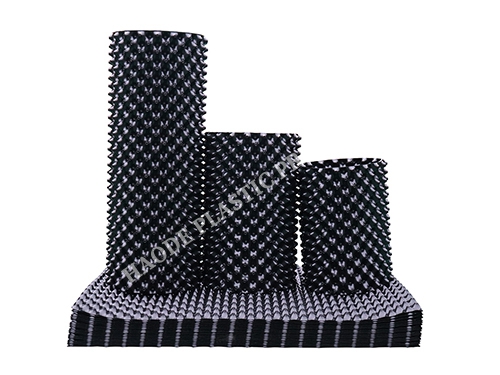How to Choose the Right Root Control Container: A Comparison of Materials and Designs
2024-08-26 12:05:46
In modern agriculture and horticulture, selecting the appropriate root control container is crucial for optimizing plant health and growth efficiency. Choosing the right container can significantly impact root development and overall plant performance. This article provides a detailed comparison of different materials and designs of root control containers to help you make an informed decision and achieve better planting results.

1. Basic Functions of Root Control Containers
1.1 Controlling Root Growth Direction
The core function of root control containers is to guide the direction of root growth, preventing excessive spreading or entanglement. By employing well-designed structures, these containers help roots form a more uniform distribution in the soil or growing medium, improving root absorption efficiency.
1.2 Improving Root Environment
Root control containers also enhance the root environment by providing good ventilation, drainage, and moisture retention. These features support healthy root growth, preventing root diseases and rot, and ensuring plants receive adequate water and oxygen.
2. Comparison of Materials for Root Control Containers
2.1 Plastic Root Control Containers
Advantages:
Durability: Plastic containers are sturdy and durable, maintaining performance over long-term use.
Cost-Effective: Generally more affordable, making them suitable for large-scale planting.
Easy to Clean: Plastic is easy to clean and disinfect, reducing the risk of disease spread.
Disadvantages:
Environmental Impact: Plastic is non-degradable and has a significant environmental footprint.
Limited Aeration: While plastic containers typically have drainage holes, their aeration is usually less effective compared to other materials.
2.2 Metal Root Control Containers
Advantages:
Corrosion Resistance: Metal containers are often treated to resist rust and corrosion.
Stability: Metal provides stability and is suitable for heavy or robust plants.
Disadvantages:
Weight: Metal containers are heavier, which may not be ideal for lighter, portable planting setups.
Higher Cost: Metal containers tend to be more expensive than plastic or paper options.
2.3 Paper Root Control Containers
Advantages:
Environmental Friendliness: Made from recyclable paper pulp, these containers are eco-friendly.
Biodegradability: They decompose naturally after use, reducing waste.
Good Aeration: Paper provides excellent air permeability, promoting healthy root growth.
Disadvantages:
Durability: Paper containers are prone to moisture damage and have a shorter lifespan.
Higher Cost: Generally more expensive, making them less suitable for large-scale applications.
2.4 Biodegradable Root Control Containers
Advantages:
Eco-Friendly: Made from plant fibers or other biodegradable materials, these containers are environmentally friendly.
Waste Reduction: They break down naturally, minimizing plastic waste.
Good Aeration: They offer good air permeability, supporting healthy root development.
Disadvantages:
Higher Cost: Biodegradable containers are often more expensive.
Moisture Sensitivity: They can deform or degrade in high moisture conditions.
3. Comparison of Designs for Root Control Containers
3.1 Traditional Design
Characteristics:
Basic Design: Features simple grids or holes, focusing on root direction control and drainage.
Suitable For:
General Planting Needs: Meets basic root control requirements, suitable for standard planting situations.
3.2 Smart Design
Characteristics:
Integrated Technology: Combines sensors and automated systems to monitor and adjust root conditions in real-time.
Data Analysis: Uses data to optimize growing conditions, enhancing plant growth efficiency.
Suitable For:
High-Tech Agriculture: Ideal for precision agriculture and projects requiring precise control of root environments.
3.3 Modular Design
Characteristics:
Adjustable: Allows users to combine and expand components based on needs.
High Flexibility: Can be adapted to different planting conditions and space requirements.
Suitable For:
Flexible Planting Projects: Suitable for projects needing adjustable planting scales and layouts.
4. How to Choose the Right Root Control Container
4.1 Consider Plant Type
Choose a container based on the plant’s root characteristics and growth needs. For deep-rooted plants, opt for deeper containers; for shallow-rooted plants, choose shallower ones.
4.2 Environmental Conditions
Factor in humidity, temperature, and ventilation in the growing environment. Select a container material and design that meets these specific conditions.
4.3 Budget
Choose materials and designs based on your budget. Although high-tech and eco-friendly containers may have higher upfront costs, they can offer better long-term growth outcomes and economic benefits.
4.4 Longevity of Use
For long-term use, select durable materials like metal or high-quality plastic. For short-term or one-time uses, paper or biodegradable containers might be more appropriate.
Conclusion
Selecting the right root control container is crucial for optimizing plant health and growth efficiency. By understanding the advantages and disadvantages of different materials and designs, you can choose the container that best fits your plant type, environmental conditions, and budget. Whether opting for traditional, smart, or modular designs, making an informed choice will help you achieve more efficient and healthier plant cultivation.

The CNC Seed Braiding Machine is a high-precision, fully automated agricultural equipment s...

It adopts electrical integration and can be started by pressing the fully automatic button ...

The XP750 seeder has stable performance, excellent product quality, simple and convenient o...

It adopts electrical integration and can be started by pressing the fully automatic button ...



